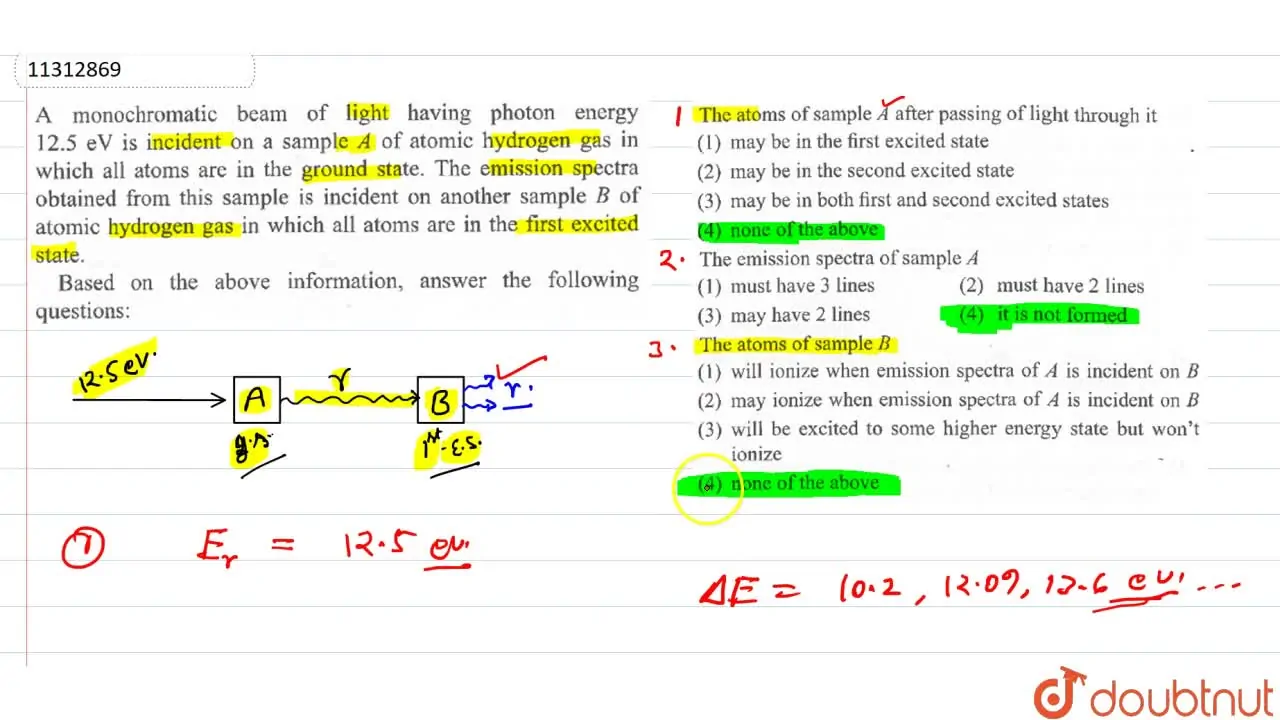A monochromatic beam of light having photon energy 12.5eV is incident on a simple A of atomic hydrogen gas in which all almost are in the ground state. The emission spectra obtained from this sample is incident on another sample B of atomic hydrogen gas in which all atoms are in the first excited state.
Based on above information, answer the following question:
The atoms of sample A after passing of light through it
may be in the first excited state
may be in the second excited state
may be in both first and second excited state
None of above.
The correct Answer is:D
As photon energy of incident light is not equal to energy difference between two energy state, that is why sample A does not absorbe any photon and therefore remain in ground state, and hence , no emission spectra. Thus sample B remain as it is, but it will be de-excite itself to ground state by emitting radiations of energy 10.2eV

when photon energy is replaced by electron beam, then atom of sample A can absorb either 10.2eV("to reach" 1^(st)excitedstate)of12.1 eV ("to reach" 2nd "excited state")InemissionspectraA,wewillhave3timecorrespond∈g→n = 2→1, n = 3→2andn = 3→1hav∈ge≠rgiesequal→10.2 eV, 1.9 eV, 12.1 eV,respectively<br>As≤∗e≠rgyofthisemissionspectraiscorrespond∈g→transitionomn = 2→3andsamp≤Bis∈1^(st)excitedstateBcanbeexcited→somehighere≠rgy≤velandifB|or|bse≠rgycorrespond∈g→n = 1→2andn = 1 to 3, then it may ionize.
Related Playlists
- BOOK - CENGAGE PHYSICSCHAPTER - ATOMIC PHYSICSEXERCISE - Integer4videos
ATOMIC PHYSICS
- BOOK - CENGAGE PHYSICSCHAPTER - ATOMIC PHYSICSEXERCISE - Fill In The Blanks8videos
ATOMIC PHYSICS
- BOOK - CENGAGE PHYSICSCHAPTER - ATOMIC PHYSICSEXERCISE - Multiple Correct13videos
ATOMIC PHYSICS
- BOOK - CENGAGE PHYSICSCHAPTER - ALTERNATING CURRENTEXERCISE - QUESTION BANK65videos
ALTERNATING CURRENT
- BOOK - CENGAGE PHYSICSCHAPTER - ATOMSEXERCISE - QUESTION BANK40videos
ATOMS
Similar Questions
A monochromatic beam of light having photon energy 12.5eV is incident on a simple A of atomic hydrogen gas in which all almost are in the ground state. The emission spectra obtained from this sample is incident on another sample B of atomic hydrogen gas in which all atoms are in the first excited state.
Based on above information, answer the following question:
The emission spectra of sample AView SolutionThe energy of hydrogen atom in the first excited state is ____
View SolutionEnergy in the ground state of hydrogen atom is -13.6 eV. What is the energy in the first excited state ?
View SolutionWhen a hydrogen atom is excited from ground state to first excited state then
View SolutionA photon of energy 12.09eV is completely absorbed by a hydrogen atom initially in the ground state. The quantum number of excited state is
View SolutionA photon beam of energy 12.1eV is incident on a hydrogen atom. The orbit to which electron of H-atom be excited is
View SolutionA photon beam of energy 12.1 eV is incident on a hydrogen atom. The orbit to which electron of H-atom be excited is
View SolutionA photon of energy 12.09eV is completely absorbed by a hydrogen atom initially in the ground state. The quantum number of excited state is
View SolutionWhen a hydrogen atom is excited from ground state to first excited state, then
View SolutionA: If a beam of photons of energy 10.0 eV each is incident on a sample of hydrogen gas containing all atoms in the ground state, then the beam of the photons is completely transmitted through the gas without absorption.
R: The minimum energy required by an electron to make a transition to an excited state is 10.2eV.View Solution


